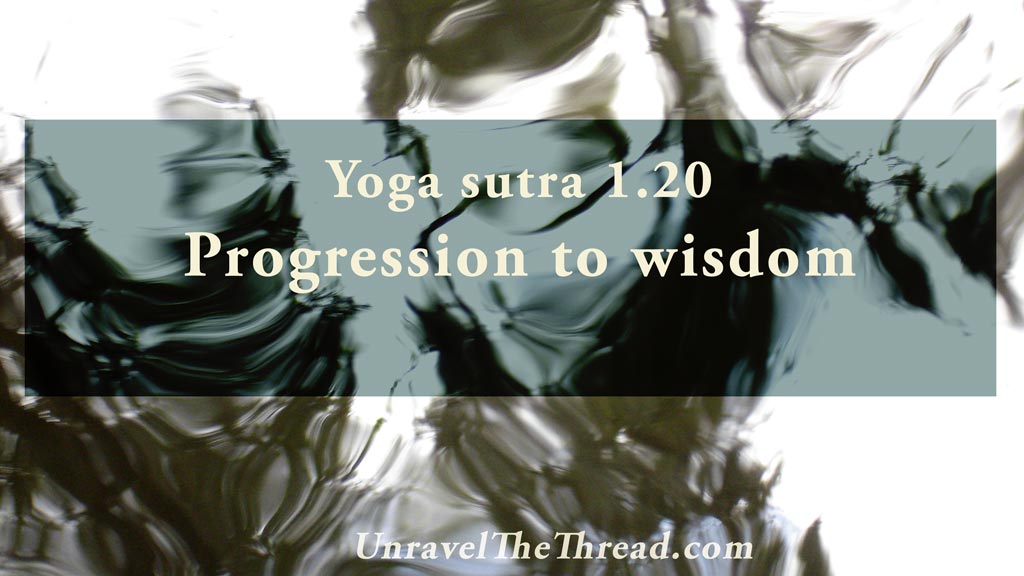
1.20 Progression to wisdom
August 25, 2019My yoga practice
September 1, 2019
1.20 Progression to wisdom
August 25, 2019My yoga practice
September 1, 20191.21 and 1.22 Commitment and intensity


1.21 It is near for those who apply themselves with intensity.
1.22 There are three degrees of intensity within each level: mild, moderate and excessive.
After sutra 1.20 indicates a path towards deep serenity, these two sutras further explain that the level of commitment in following the path will influence the results. Earlier in this chapter, in verses 1.2 and 1.12, self-regulation appeared as a major theme in the Yoga Sutra. Self-regulation appears again here: evenness of mind and wisdom are near for the practitioners who apply themselves with intensity. The intensity itself can be mild, moderate or excessive. Each person, at each moment, is in charge of finding the right level of intensity balancing firm and unwavering commitment with a heartfelt and compassionate attitude. Too much commitment may make you rigid or dogmatic, whereas too much detachment may lead you to avoid applying yourself to the best of your ability. Here is where being aware of your tendencies is invaluable, because it enables you to fine-tune your level of intensity, so that it is an appropriate and sustainable way to achieve the perfect balance between doing and being.
Your actions provide an excellent mirror to notice the quality of your attention and the level of intensity that you bring into your daily activities. Yoga practice is often conducted in a space where sources of distractions are reduced, so that you can observe how you go about engaging with your practice. Noticing your attitude and your drive can give you insight into your ways of being. In fact, all yoga techniques, whether they are directed to your body, breathing, mind or emotions, can be quite effective in revealing your tendencies and ways of being. For instance, the person who tends to overreach in her professional and personal life is likely to also overreach in her asana, pranayama and meditation practices. You can use your practice as a way to measure your level of commitment and the right amount of intensity, so that your practice is sustainable and enjoyable. If the practice is not enjoyable, it becomes an exercise in self-torture, and that is very difficult to sustain over a long period of time. In fact, being consistent is a challenge for most of us.
Consistent practice is a test to your commitment. Sutra 1.21 highlights that each practitioner is in charge of the level of his commitment to the goal of yoga. You choose. This means that it is totally up to you to decide how you apply to your practice. This is excellent news. At the same time, if you are the one who makes the choices, that means that you cannot blame anybody else for your lack of commitment. Is it possible that your level of commitment is proportional to the sense of urgency to be present in your own life? This is where it is critical that you clarify what is important enough for you to invest your time and energy on. Additionally, when you practice with awareness, instead of mechanically, some of your patterns and pains will become more evident. For example, the more you tune into the rhythms of your body, the discomforts and soreness that you have learned to ignore may become more apparent. This is a testament that your practice is working, because you are shining the light of awareness into areas you have not addressed. Of course, you can choose to ignore those signs, or to sedate your senses not to feel discomfort. Or you can, instead, address the cause of your soreness. Each choice requires a different degree of commitment. There are some obstacles that emerge for many of us. For instance, as we set our intention, we may immediately hear the inner critic downplaying the importance of that intention. How can you learn to trust yourself and your choices so that you can avoid self-sabotage? To what extent is there a sense of urgency in you to practice because your practice enables you to participate fully in each irreplaceable moment of your life? Also, yoga offers a broad spectrum of practices to address challenges at the physical, mental, emotional and interpersonal levels. Is your practice balanced and balancing? If your practice leaves you exhausted, how is your practice enriching your life? Can your yoga practice offer you a daily opportunity to experience what enough is for you each day? What are you committed to? What is your level of commitment to: yourself? To living in awareness? To growing out of the patterns that are no longer useful? To showing up to every moment of your life? What are the signs of your commitment?
As usual, one more way of exploring the meaning of this sutra is by chanting it.
You can choose to chant it in its traditional form with all the words coming together:
1.21 tīvrasaṃvegānāmāsannaḥ तीव्रसंवेगानामासन्नः ॥२१॥
1.22 mṛdumadhyādhimātratvāttato’pi viśeṣaḥ मृदुमध्याधिमात्रत्वात्ततोऽपि विशेषः ॥२२॥
Another option is to chant each word in each sutra individually.
For sutra 1.21:
- tīvra
- saṃvegānām
- āsannaḥ
And for sutra 1.22:
- mṛdu
- madhyā
- adhimātratvāt
- tataḥ
- api
- viśeṣaḥ
Unravel the thread is now available as a book!
If you find Simple-Yoga.org and Unravel the thread useful, consider supporting my labor with a donation, you may also donate using PayPal or Venmo. Thank you!